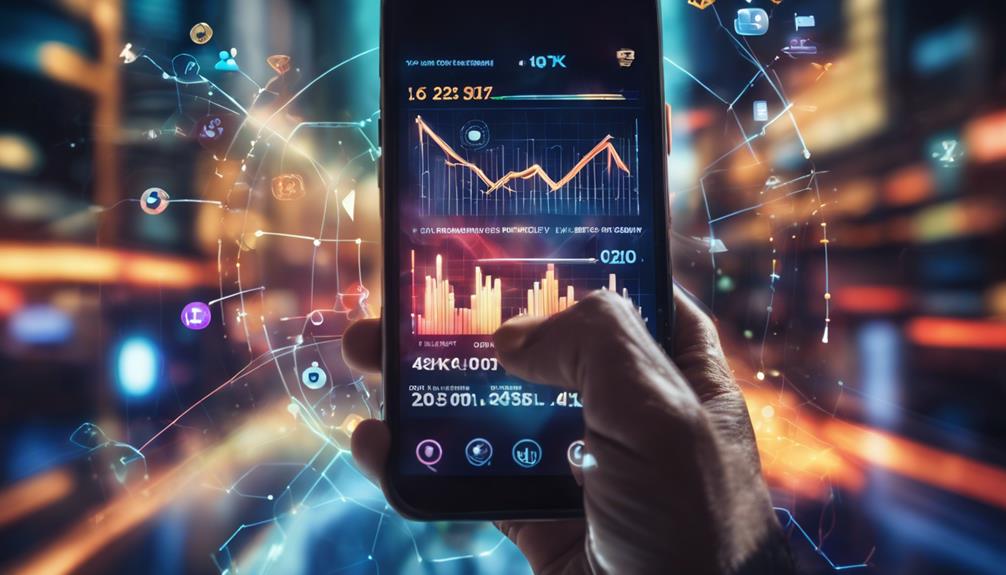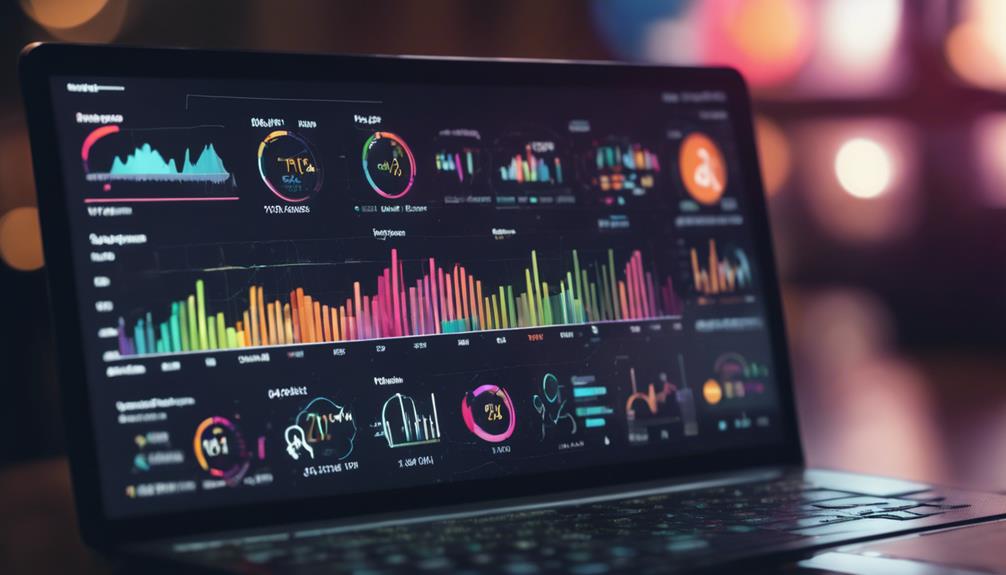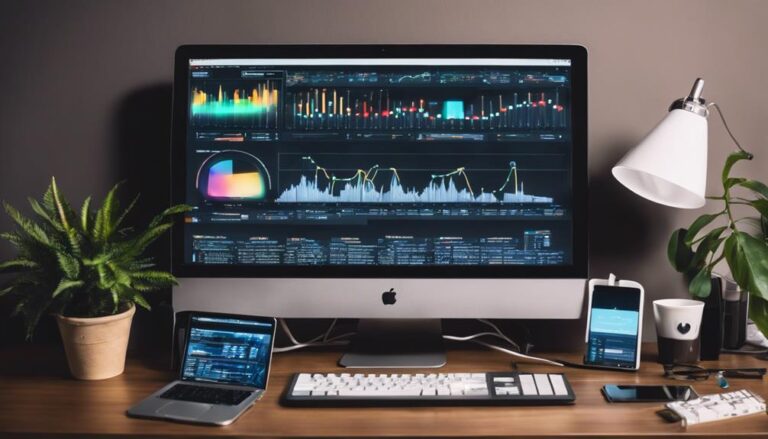Harnessing social media analytics lets me make smarter, data-driven decisions. I use real-time monitoring to track brand mentions, analyze sentiment, and study competitor activity. AI helps with instant customer responses, enhancing engagement. By diving into audience behavior, I tailor campaigns and optimize content for maximum reach. Real-time insights allow me to adjust on-the-fly, ensuring each campaign achieves top ROI. This process identifies emerging opportunities and aligns marketing strategies with audience preferences. Want to discover how to elevate your social media marketing with these powerful tools?
Key Takeaways
- Use AI to monitor brand mentions and conduct sentiment analysis for real-time feedback.
- Optimize campaigns dynamically using real-time data dashboards and alerts.
- Analyze audience demographics and preferences to tailor personalized marketing messages.
- Adapt content strategies based on user sentiment feedback and A/B testing results.
- Employ data-driven insights to refine targeting and improve content relevance.
Benefits of Social Media Analytics
Leveraging social media analytics gives businesses precise insights into customer preferences, enabling data-driven decision-making. Through real-time monitoring, I can quickly respond to evolving trends and customer feedback. This continuous stream of data enhances market research, providing valuable information for strategic decision-making.
By measuring campaign effectiveness, I can optimize marketing strategies, ensuring better ROI and more targeted outreach. Additionally, social media analytics revolutionize project management by offering data-driven insights that guide decision-making processes. With these tools, understanding customer preferences becomes straightforward, and I can make informed decisions that align with market demands.
Ultimately, social media analytics empower me to refine strategies and stay ahead in a competitive landscape, driving innovation and efficiency throughout the organization.
AI in Social Media Monitoring
Building on the benefits of social media analytics, AI in social media monitoring amplifies these advantages by employing machine learning algorithms to analyze vast amounts of data for actionable insights. These algorithms efficiently detect patterns, trends, and anomalies, enabling real-time insights into brand mentions, sentiment analysis, and competitor activities.
| Key Feature | Benefit |
|---|---|
| Brand Mentions | Tracks mentions to manage brand reputation |
| Sentiment Analysis | Gauges public sentiment for feedback |
| Competitor Activities | Monitors rivals to stay competitive |
| Customer Queries | Responds promptly, enhancing engagement |
Real-Time Data Insights

How can real-time data insights revolutionize our approach to social media analytics?
By leveraging real-time data insights, I can transform my strategy, making it more responsive and effective. Social media analytics tools like Sprinklr provide real-time monitoring, offering immediate feedback on campaign performance and audience engagement.
With real-time data, I can:
- Quickly identify and capitalize on emerging opportunities.
- Optimize campaigns on-the-fly to maximize ROI.
- Address customer concerns promptly, enhancing customer engagement.
- Track key metrics with real-time dashboards and alerts.
- Stay ahead of competitors by making timely decisions.
Audience Behavior Analysis
Real-time data insights not only enhance campaign responsiveness but also provide a deeper understanding of audience behavior, enabling more personalized and effective marketing strategies. Utilizing social media analytics to study audience demographics and preferences allows me to tailor personalized marketing messages that resonate better. By analyzing audience behavior, I can enhance content relevance and boost engagement. Additionally, insights into audience analysis inform ideal posting schedules, ensuring maximum reach and impact. Here's a snapshot of key metrics:
| Metric | Insight | Application |
|---|---|---|
| Audience Demographics | Age, gender, location | Targeted ad campaigns |
| Audience Preferences | Liked content types | Content creation |
| Engagement | Likes, shares, comments | Engagement strategies |
| Behavior Patterns | Active hours, interaction | Posting schedules |
| Content Relevance | Resonance with audience | Content optimization |
This data-driven approach refines marketing strategies, making them more effective and innovative.
Enhancing Content Strategy

Analyzing social media data enables me to pinpoint high-engagement content types, driving a more effective content strategy. By diving deep into the data, I can:
- Optimize posting schedules to increase reach and interaction rates.
- Refine targeting to guarantee content relevance and resonate with my audience.
- Adapt content based on user sentiment feedback for improved audience engagement.
- Employ A/B testing to validate new strategies and continuously improve.
- Leverage data-driven insights to make informed decisions.
These steps allow me to craft a robust content strategy that not only engages but also converts.
By analyzing trends and patterns, I stay ahead in creating content that matters.
This data-driven approach maximizes audience engagement and ensures that my content remains relevant and impactful.
Campaign Performance Metrics
Building on a robust content strategy, I now turn my focus to campaign performance metrics to gauge the effectiveness of my social media efforts.
In the domain of social media analytics, key metrics like engagement rate, reach, impressions, clicks, and conversions offer invaluable insights into audience interactions and campaign success.
By diving into these numbers, I can make data-driven decisions that optimize strategies for better results and ROI. Engagement rate and conversions, in particular, reveal how well my campaigns resonate with the target audience.
Tracking these metrics allows me to continually refine my approach, ensuring each campaign not only meets but exceeds performance expectations. Ultimately, a thorough analysis of campaign performance metrics is essential for achieving sustainable marketing success.
Competitive Benchmarking

Competitive benchmarking in social media analytics empowers me to compare my brand's performance metrics against those of my competitors, revealing important insights into strengths, weaknesses, and market opportunities. By analyzing competitor engagement, reach, and audience demographics, I can uncover valuable industry trends and best practices. This process is essential for refining my content strategy and adjusting posting frequency to enhance targeting.
Competitive benchmarking enables me to:
- Identify strengths and weaknesses in my current approach.
- Spot market opportunities by examining gaps in competitor content.
- Analyze industry trends to stay ahead of market shifts.
- Understand audience demographics for better-targeted campaigns.
- Refine content strategy based on competitor success and failures.
Competitive benchmarking is vital for making data-driven decisions and maintaining a competitive edge.
ROI Improvement Strategies
Maximizing ROI in social media analytics requires leveraging targeted content strategies, real-time campaign optimization, and insightful competitive analysis. By implementing targeted content strategies based on audience preferences, as shown by Sprinklr Social analytics, I've seen a 327% ROI improvement over three years.
Audience analysis allows me to precisely target segments in marketing campaigns, ensuring I reach the right people. Competitive analysis identifies competitors' weaknesses, providing opportunities for ROI improvement.
Real-time optimization driven by feedback analysis from social media analytics maximizes campaign effectiveness. Utilizing data-driven decision-making through sentiment analysis, post engagement analysis, and influencer impact analysis enables me to continuously refine strategies and achieve significant ROI improvement.
This holistic approach is essential for innovative marketing success.
Frequently Asked Questions
What Is Social Media Analytics in Marketing?
Social media analytics in marketing tracks user demographics, sentiment analysis, engagement metrics, influencer identification, content performance, trend analysis, competitor benchmarking, audience segmentation, conversion tracking, and hashtag performance to optimize strategies and drive innovation.
How to Enhance Social Media Marketing?
I enhance social media marketing by leveraging influencer partnerships, curating engaging content, and utilizing visual storytelling. I focus on brand monitoring, community management, and social listening to boost customer engagement while encouraging user-generated content and viral challenges for audience segmentation.
How Can Social Media Analytics Be Used to Improve a Company's Marketing Strategy?
I use social media analytics to understand customer behavior, analyze influencer impact, and evaluate content performance. By segmenting audiences, identifying trends, and conducting sentiment analysis, I optimize campaigns and target demographics, enhancing engagement metrics and competitive analysis.
What Are 3 Social Media Marketing Strategies?
Imagine social media as an ever-evolving garden. I'd cultivate it with influencer partnerships for reach, video marketing using storytelling techniques for engagement, and hashtag campaigns for audience segmentation. These strategies guarantee brand consistency and captivate niche communities.
Conclusion
To sum up, harnessing social media analytics can revolutionize your marketing strategy. With AI, real-time insights, and precise audience behavior analysis, you're better equipped to enhance content and measure campaign performance.
One intriguing stat: 72% of companies using data-driven marketing have reported increased revenue. By focusing on competitive benchmarking and ROI improvement, you're not just keeping up—you're setting new standards.
Explore the data, and watch your social media efforts thrive.






